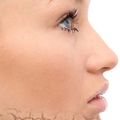 Nose reshaping, or rhinoplasty, is one of the most common plastic surgery procedures performed today. Often, the structure or size of the nose is not proportionate with the other features on the face. Nose reshaping procedures can help to correct the disproportionate appearance of the nose by altering the size or shape of the nose, the span of the nostrils, or the angle between the nose and the upper lip. In addition, nose reshaping procedures may be performed to correct a nasal birth defect or injury as well as chronic breathing problems. It is important to realize that individuals considering a nose reshaping procedure should be at least fifteen years of age, as this procedure should only be performed after the nose has finished developing completely.
Nose reshaping, or rhinoplasty, is one of the most common plastic surgery procedures performed today. Often, the structure or size of the nose is not proportionate with the other features on the face. Nose reshaping procedures can help to correct the disproportionate appearance of the nose by altering the size or shape of the nose, the span of the nostrils, or the angle between the nose and the upper lip. In addition, nose reshaping procedures may be performed to correct a nasal birth defect or injury as well as chronic breathing problems. It is important to realize that individuals considering a nose reshaping procedure should be at least fifteen years of age, as this procedure should only be performed after the nose has finished developing completely.
Nasal Anatomy
Before you learn how nose reshaping procedures work, it is important that you understand the anatomy of the nose. The framework of the nose is primarily made of bone and cartilage. The upper portion of the nose is supported by bone. Dorsal humps, which are areas of built up cartilage or bone, can form along the dorsum, or ridge of the nose. The lower portion of the nose is supported by different plates of cartilage that extend laterally from the center of the nose, determining the shape and appearance of the nasal tip.
How a Closed Rhinoplasty Works
During a closed rhinoplasty procedure, the physician makes small incisions inside the nostrils to gain access to the bone and cartilage. In contrast to an open rhinoplasty, the skin is not lifted away from the framework of the nose. Using very small instruments, the physician will reshape the nose by removing or adding bone, cartilage, and tissue to achieve the desired appearance. While some physicians prefer the closed technique due to shorter procedure and recovery time, both types of procedures can produce excellent results.
Surgery Preparation
A closed rhinoplasty procedure may last approximately one to two hours. Prior to the start of your procedure, the treatment area will be cleansed and an anesthetic will be administered. Your physician may choose to administer a local anesthetic and a sedative, in which the nose and surround areas are numb and you are in a relaxed state during the procedure. In contrast, the procedure may be performed with general anesthesia in which you are asleep.
Reshaping the Tip of the Nose
To begin the procedure, the physician will generally make two small incisions inside each nostril in order to gain access to the cartilage and bone. In patients whose nasal tip is wide or bulbous, the physician may choose to remove a portion of the alar cartilage from the tip of the nose. Depending on your anatomy and the extent of treatment necessary, the physician may choose to use sutures to bend or pull the alar cartilages inward to create a narrower tip or adjust its position.
Removing the Dorsal Hump
One of the primary goals of nose reshaping is often to remove a dorsal hump. The dorsal hump usually consists primarily of cartilage and some bone. In order to remove the dorsal hump, the physician may choose to use an osteotome, which is a chisel-like device used to cut bone. Using the osteotome, the physician carves away areas of cartilage and bone. Following the removal of the dorsal hump, your nose may have what is known as an open roof, which is an open space between the nasal bones. The physician may use a fine surgical rasp to smooth the ridges of the nasal bones. In addition, they will perform an osteotomy to reposition the nasal bones and close the open roof.
Osteotomy
An osteotomy involves breaking the nasal bones in order to reposition them. Although it is not always necessary, an osteotomy can be performed to correct a high nasal dorsum with a dorsal hump, close an open roof after the removal of a dorsal hump, or create a narrower base of the nose. Using an osteotome, the physician will carefully create breaks in the nasal bones by tapping the device gently along a designated path. Once broken, the nasal bones are shifted upward to close the open roof.
Incision Closure
Once the physician has finished reshaping the nose, the incisions inside the nose will usually be closed with dissolvable stitches. The physician may place nasal airway splints inside your nostrils that provide support and stabilize the nose as it heals. Steri-strips will be applied to the outside of your nose. If the nasal bones were broken during the procedure, a nasal splint will be applied as well. The bandages and splint help the tissues heal and conform to the new cartilage and bone structure.
Close Nose Reshaping Recovery
As with any surgical procedure, you will likely experience some pain, bruising, and swelling, particularly in the upper portion of your face and around your eyes. These symptoms will begin to dissipate within the first few days following surgery. Stitches, bandages, and the nasal splints may stay in place for approximately five to seven days. Although the majority of the swelling will subside within a few weeks, some minor swelling may persist for a few months.
Closed Nose Reshaping Results
Depending on your rate of recovery, the bruising will begin to fade and you will be able to return to work within seven to ten days following your procedure. As you begin to heal and the swelling in your face subsides, you will start to notice the effects of your nose reshaping procedure. However, like other surgical procedures, the final results may continue to evolve for up to one year. Although nose reshaping procedures are not intended to achieve perfection, by adjusting the proportion and profile of your nose, nose reshaping can help to significantly enhance your self-confidence and appearance.
How an Open Rhinoplasty Works
During an open rhinoplasty procedure, the physician makes small incisions across the columella and inside each nostril. In contrast to a closed rhinoplasty, these incisions allow the physician to lift the skin away from the bone and cartilage of the nose. In doing so, the physician can clearly examine the nasal framework and make precise adjustments to its shape and structure. Using very small instruments, the physician will reshape the nose by removing or adding bone, cartilage, or tissue to achieve the desired appearance. While some physicians prefer the open technique because it allows them to better assess nasal bone and cartilage, both types of procedures can produce excellent results.
Surgery Preparation
An open rhinoplasty procedure may last approximately two to four hours. Prior to the start of your procedure, the treatment area will be cleansed and an anesthesia will be administered. Your physician may choose to administer a local anesthetic and a sedative, in which the nose and surrounding areas are numb and you are awake, but drowsy during the procedure. In contrast, the procedure may be performed with general anesthesia in which you are asleep.
Incisions
To begin the procedure, the physician will generally make two incisions. A small incision is made across the columella, which is the tissue that lies between the nostrils at the base of the nose. Using a retractor to expose the inside of your nose, the physician will make a second incision, known as a marginal incision, which extends from the columella incision into each nostril. Using a pair of surgical scissors, the physician will carefully dissect the skin along the columella incision to begin lifting the skin away from the underlying framework.
Lifting the Skin
Using surgical scissors and a series of retractors the physician continues to carefully dissect the skin away from the underlying cartilage. The skin is also dissected away from the nasal bone, in order to fully expose the framework of the nose. This allows the physician to make precise adjustments to its shape.
Reshaping the Tip of the Nose
An open rhinoplasty often best allows the physician to alter the shape of the tip of the nose. In patients whose nasal tip is wide or bulbous, the physician may choose to remove a portion of the alar cartilage from the tip of the nose. Depending on your anatomy and the extent of treatment necessary, the physician may choose to use sutures to bend or pull the alar cartilages inward to create a narrower tip or adjust its position.
Removing the Dorsal Hump
One of the primary goals of nose reshaping is often to remove a dorsal hump. The dorsal hump usually consists primarily of cartilage and some bone. In order to remove the dorsal hump, the physician may choose to use an osteotome, which is a chisel-like device used to cut bone. Using the osteotome, the physician carves away areas of cartilage and bone. Following the removal of the dorsal hump, your nose may have what is known as an open roof, which is an open space between the nasal bones. The physician may use a fine surgical rasp to smooth the ridges of the nasal bones. In addition, they will perform an osteotomy to reposition the nasal bones and close the open roof.
Osteotomy
An osteotomy involves breaking the nasal bones in order to reposition them. Although it is not always necessary, an osteotomy can be performed to correct a high nasal dorsum with a dorsal hump, close an open roof after the removal of a dorsal hump, or create a narrower base of the nose. Using an osteotome, the physician will carefully create breaks in the nasal bones by tapping the device gently along a designated path. Once broken, the nasal bones are shifted upward to close the open roof.
Incision Closure
Once the physician has finished reshaping the nose, the incisions inside the nose will usually be closed with dissolvable stitches. The physician may place nasal airway splints inside your nostrils that provide support and stabilize the nose as it heals. Steri-strips will be applied to the outside of your nose. If the nasal bones were broken during the procedure, a nasal splint will be applied as well. The bandages and splint help the tissues heal and conform to the new cartilage and bone structure.
Open Rhinoplasty Recovery
As with any surgical procedure, you will likely experience some pain, bruising, and swelling, particularly in the upper portion of your face and around your eyes. These symptoms will begin to dissipate within the first few days following surgery. Stitches, bandages, and the nasal splints may stay in place for approximately five to seven days. Although the majority of the swelling will subside within a few weeks, some minor swelling may persist for a few months.
Open Rhinoplasty Results
Depending on your rate of recovery, the bruising will begin to fade and you will be able to return to work within seven to ten days following your procedure. As you begin to heal and the swelling in your face subsides, you will start to notice the effects of your nose reshaping procedure. However, like other surgical procedures, the final results may not be noticeable until one year after your procedure. Although it is important to realize that nose reshaping procedures are not intended to achieve perfection, by adjusting the proportion and profile of your nose, nose reshaping can help to significantly enhance your self-confidence and appearance.
otoplasty
Enhancing your appearance with ear surgery
If protruding or disfigured ears bother you or your child, you may consider plastic surgery. Ear surgery — also known as otoplasty — can improve the shape, position or proportion of the ear. It can correct a defect in the ear structure that is present at birth that becomes apparent with development or it can treat misshapen ears caused by injury. Ear surgery creates a natural shape, while bringing balance and proportion to the ears and face. Correction of even minor deformities can have profound benefits to appearance and self-esteem.
Specifically ear surgery can treat:
Overly large ears — a rare condition called macrotia. Protruding ears occurring on one or both sides in varying degrees — not associated with hearing loss. Adult dissatisfaction with previous ear surgery.
Is it right for me?
Ear surgery is a highly individualized procedure and you should do it for yourself, not to fulfill someone else’s desires or to try to fit any sort of ideal image.
Children who are good candidates for ear surgery are:
Healthy, without a life-threatening illness or untreated chronic ear infections. Generally 5 years old, or when a child’s ear cartilage is stable enough for correction.
Teenagers and adults who are good candidates for ear surgery are:
Healthy individuals who do not have a life-threatening illness or medical conditions that can impair healing. Non-smokers. Individuals with a positive outlook and specific goals in mind for ear surgery.
Prior to surgery, you may be asked to:
Get lab testing or a medical evaluation. Take certain medications or adjust your current medications. Stop smoking well in advance of surgery. Avoid taking aspirin and certain anti-inflammatory drugs and herbal supplements as they can increase bleeding
What happens during ear surgery?
Step 1 – Anesthesia
Medications are administered for your comfort during the surgical procedure. The choices include local, intravenous sedation or general anesthesia. Your doctor will recommend the best choice for you.
Step 2 – The incision
Correction of protruding ears uses surgical techniques to create or increase the antihelical fold (just inside the rim of the ear) and to reduce enlarged conchal cartilage (the largest and deepest concavity of the external ear). Incisions for otoplasty are generally made on the back surface of the ear. When incisions are necessary on the front of the ear, they are made within its folds to hide them. Internal, non-removable sutures are used to create and secure the newly shaped cartilage in place.
Step 3 – Closing the incisions
External stitches close the incision. Techniques are individualized, taking care not to distort other structures and to avoid an unnatural “pinned back” appearance.
Step 4 – See the results
Ear surgery offers near immediate results in cases of protruding ears, visible once the dressings that support the new shape of the ear during initial phases of healing are removed. With the ear permanently positioned closer to the head, surgical scars are either hidden behind the ear or well-hidden in the natural creases of the ear.
Ear surgery recovery
Discomfort immediately following ear surgery is normal and can be controlled with pain medication. There may be an itchy feeling under bandages. It is essential that bandages remain intact and are not removed, for any reason. Failure to do so may result in loss of some of the correction and may require a secondary surgery.
The practice of medicine and surgery is not an exact science. Although good results are expected, there is no guarantee. In some situations, it may not be possible to achieve optimal results with a single surgical procedure and another surgery may be necessary.
Results and outlook
Ear surgery offers almost immediate results in cases of protruding ears, visible when the dressings that support the new shape of the ear during initial phases of healing are removed. With the ear permanently positioned closer to the head, surgical scars are either hidden behind the ear or well hidden within the natural creases of the ear. The results of more extensive ear surgery and reconstruction may appear in stages over time.






